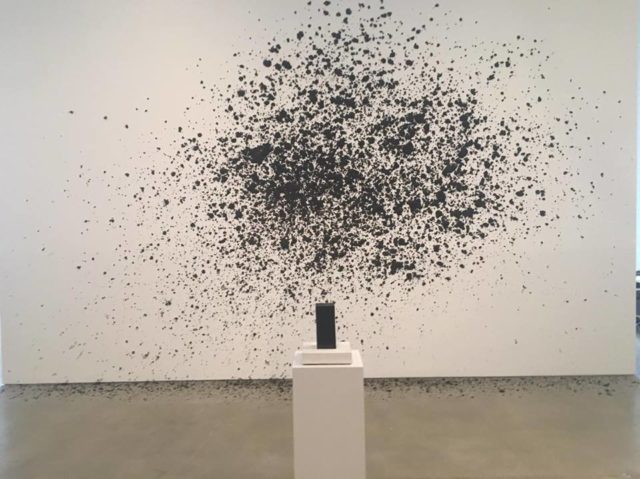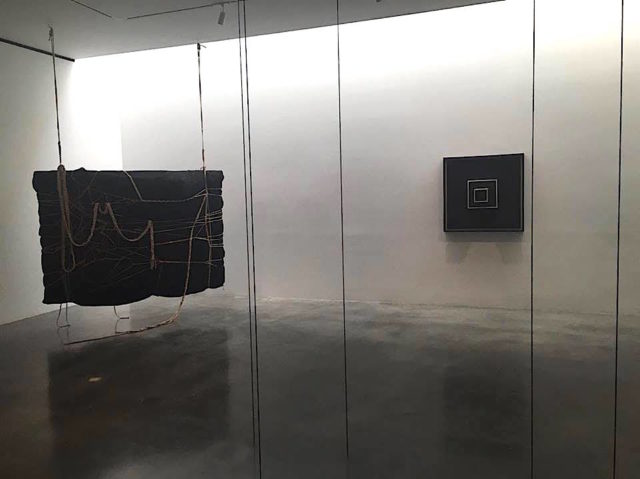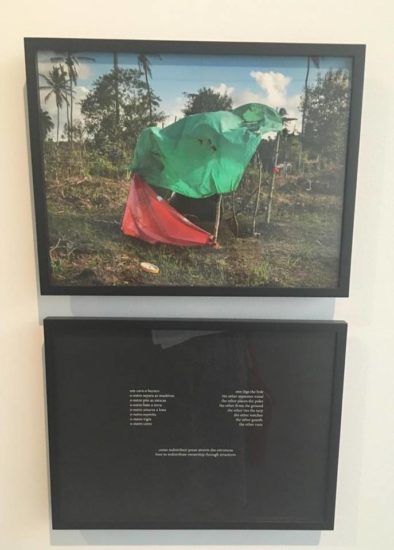
Wangechi Mutu’s “Throw” at Blackness in Abstraction (all photos by author for Art F City)
Blackness in Abstraction
Pace Gallery
510 West 25th Street, New York, NY
On view through August 19, 2016
Artists: Terry Adkins, Jonathas de Andrade, Rasheed Araeen, Kevin Beasley, Sergio de Camargo, Kōji Enokura, Ellen Gallagher, Robert Irwin, Sui Jianguo, Rashid Johnson, Sol LeWitt, Glenn Ligon, Laura Lima, Turiya Magadlela, Steve McQueen, Ulrike Müller, Oscar Murillo, Wangechi Mutu, Louise Nevelson, Lorraine O’Grady, Adam Pendleton, Pope.L, Robert Rauschenberg, Ad Reinhardt, Fred Sandback, Jack Tworkov, Carrie Mae Weems, Jack Whitten, and Fred Wilson
“Black is and black ain’t.” Walking through Pace Gallery’s current exhibition Blackness in Abstraction, I began to think about that title line from Marlon Riggs’s final film—taken from the prologue of Ralph Ellison’s novel Invisible Man. Even more than the pervasive “Black is beautiful,” this curiously ambiguous phrase hints at the multitude of meanings, voices, and questions surrounding blackness in the exhibition.
Curated by Adrienne Edwards, the Walker Art Center’s visual arts curator at large, Blackness in Abstraction brings together a multigenerational group of artists who work with the color black. The show also gathers artists of varying races and ethnicities. This leads to a rich juxtaposition between abstract stalwarts like Sol LeWitt, Ad Reinhardt, Robert Rauschenberg, and Robert Irwin with black artists like Rashid Johnson, Wangechi Mutu, Terry Adkins and Carrie Mae Weems who are too often contextualized in relation to their racial identities. In contrast to shows like Radical Presence: Black Performance in Contemporary Art, Blackness in Abstraction argues that identity can be a chapter but it isn’t the whole story. The show depicts what would happen if we looked beyond an artist’s own blackness to, instead, investigate their use of blackness.
Blackness in Abstraction presents a staggering variety of approaches to blackness with sixty multidisciplinary artworks—even more counting the numerous multiples. The show takes up the entirety of Pace Gallery, further expanding its exhibition space with several temporary walls. Fred Sandback’s multi-stranded minimalist yarn sculpture stretches tautly from floor to ceiling, Glenn Ligon’s photographic appropriation of James Baldwin texts fades to black when high on the wall, and Fred Wilson’s iconic, symbol-laden flag series hangs vertically in the corners. Adam Pendleton’s coded sculptural arrangement “Untitled (code poem Los Angeles)” even provides the gallery staff with some extra anxiety due to its precarious proximity to Pace’s entrance and clumsy visitors’ steps.

Installation view of Blackness in Abstraction with Laura Lima, Sol LeWitt and Fred Sandback
Admittedly, I had to see the exhibition twice to fully appreciate the nuance of Edwards’ curatorial vision. On first glance—after a day of gallery-hopping, the dimly lit exhibition–darkened for an enormous central projection of Glenn Ligon’s video Death of Tom—seemed depressing as if it were the one goth on the beach in a glut of vibrantly colored summer shows. The exhibition’s floor-to-ceiling style was also overwhelming, particularly Oscar Murillo’s limp tarps that hung from the ceiling like bats.
And yet, on second consideration, the singular color scheme opened up numerous unconventional ways of understanding the art in the show. Much of this derives from the variety of mediums showcased in the exhibition. From video to sculpture to drawing to photography and painting, the diverse approach to materials and the similarities between these disparate mediums becomes more apparent with the show’s monochromatic simplicity.

Jack Whitten “Epsilon II” and Louise Nevelson “City-Reflection”
Take, for example, the pairing of Jack Whitten’s “Epsilon II” series with Louise Nevelson’s monumental sculpture “City-Reflection.” This seemed an unexpected combination even though the works were made only four years apart. When viewed together, the geometrical shapes and hard lines in Whitten’s painting—made from sticks, rakes and Afro combs—play off the verticality and urban architectural references in Nevelson’s rectangular sculpture.
However, some mediums don’t work as well as others. Overall, the photographic inclusions in the exhibition seem to be the weakest. Perhaps this has to do with photography’s long-held reliance on realism and documentation.

Jonathas de Andrade’s “Constructive Exercise for a Landless Guerilla”
Nowhere is this more apparent than in Brazilian photographer Jonathas de Andrade’s series “Constructive Exercise for a Landless Guerilla.” The photographs portray makeshift tents that presumably house migrants. Exhibited with the photos is a poem that describes the communal building of these tents, which de Andrade asserts reveals “how to redistribute ownership through structures.” While the photographs undeniably have value as records of anticapitalist collectivity and poverty, the images seem so literal and direct in the context of an exhibition about abstraction.
This is not to say that all the photographs in the show miss the mark. In particular, Steve McQueen’s two photographs “More” reflect the show’s rejection of a singular definition of blackness. The abstracted photographs, at first, look like a distant glimpse at the starry skies of space. And yet, on closer inspection, McQueen is actually capturing a wet sidewalk. Here, McQueen shows that blackness can be both expansively utopian and thoroughly earthbound.

Still from Lorraine O’Grady’s “Landscape (Western Hemisphere)”
The multiplicity in McQueen’s photographs mirrors the complexity that runs through the most successful works in the show, which embrace the multiple meanings of blackness. Take, for example, Lorraine O’Grady’s video “Landscape (Western Hemisphere).” Entering a separate video gallery, the viewer hears sounds of chirping birds, insects and other surrounding environmental noise. The visuals immediately appear like a wave of flowing grass blown by the wind. Rather than a landscape, O’Grady’s video animates the landscape of the flowing curls in her natural hair.
Here Edwards’ curatorial strength comes to the fore. The video is clearly a powerful embrace of natural hair as a symbol of black femininity and beauty. But it can also be understood in the abstracted context of the rippled textures of Koji Enokura’s minimalistic painting on cotton that slides down a wall outside O’Grady’s video gallery. By combining these artworks, Edwards seems to be demanding more from viewers, art historians and curators. If we look beyond blackness as an either/or category in art—as either “identity” or “color”—what new understandings will we discover?


Comments on this entry are closed.